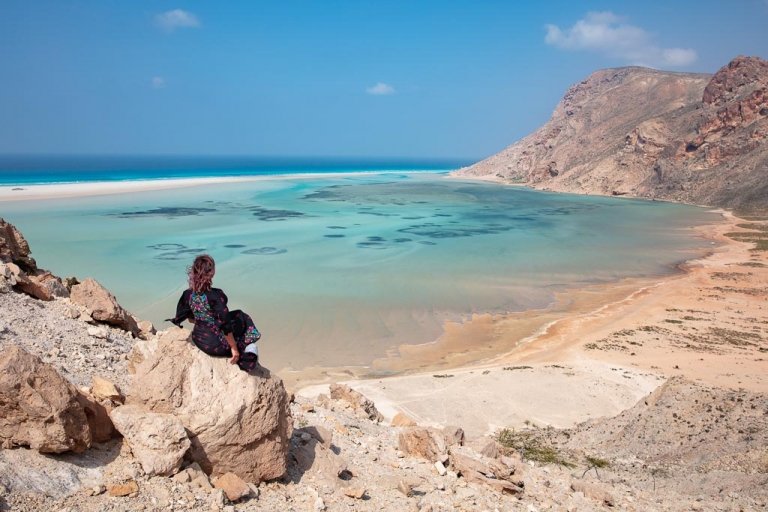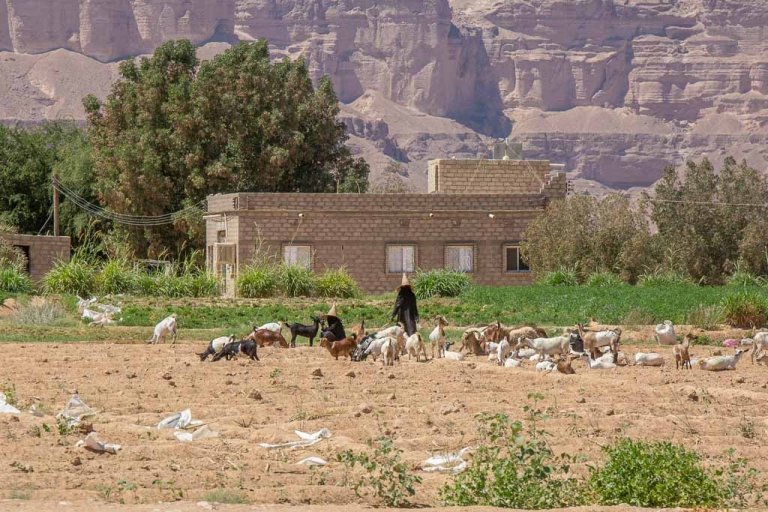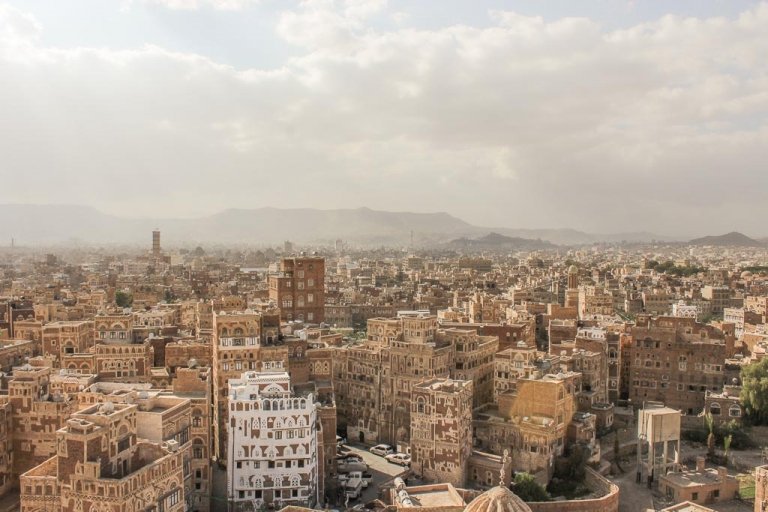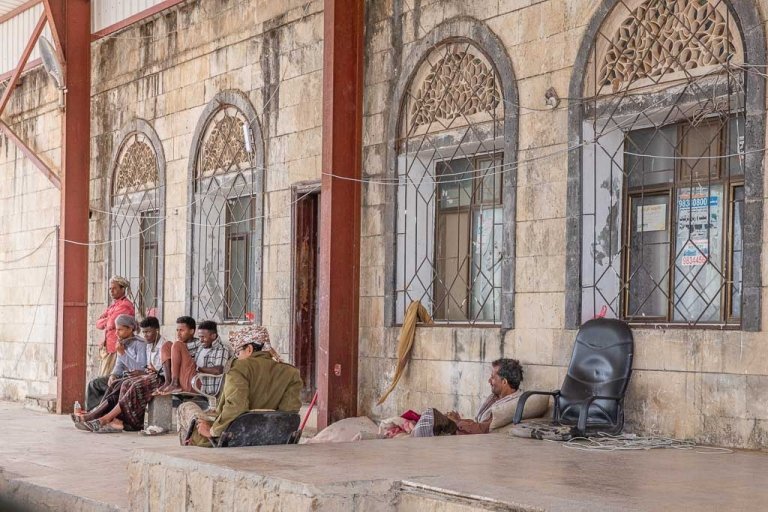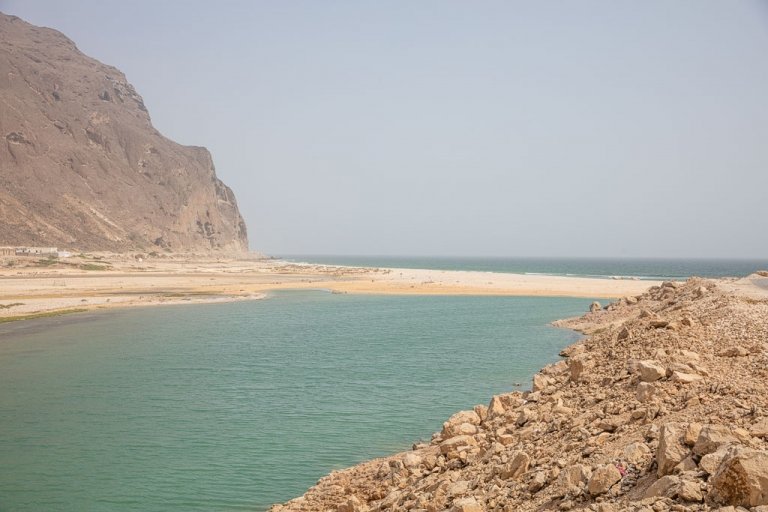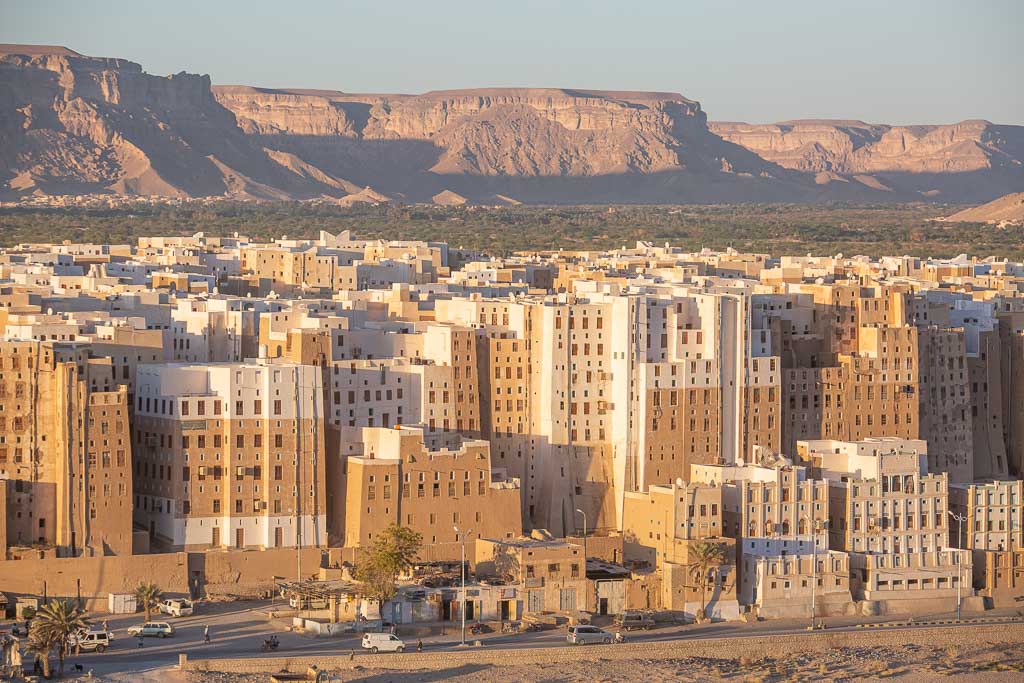
The Mud Skyscrapers Of Shibam: The Manhattan Of The Desert
Updated April 2023, The Mud Skyscrapers Of Shibam: The Manhattan Of The Desert was originally published in May 2020
I had thought that watching the sunset from a nearby lookout as the Maghrib call to prayer ring out over Wadi Hadhramaut would be the ultimate experience in Shibam, Yemen’s famed walled mudbrick city. What I didn’t expect was that the highlight and real magic would happen bound within those city walls. On my most recent trip to Yemen, I was finally able to visit the ancient city of Shibam.
Wanna learn more? Check out my Yemen Travel Guide

A Quick History Of Shibam
Shibam is the oldest city in the world to have used vertical construction techniques, some of the buildings reaching as high as eleven stories. The city even predates the spread of Islam in the Arabian Peninsula as it was known to exist as early as the 4th century, however, much of the construction present today occurred after 1532 AD.
Strategically placed, Shibam sits on a rocky knoll in the center of Wadi Hadhramaut for three main purposes: To avoid inundation when flash floods strike in Hadhramaut, a city within close proximity of its crops and fields, and for defense as enemies could be seen from a distance from its elevated location.
Shibam would go on to emerge as an important caravan stop along the ancient Frankincense trade route.
In the 10th century, the city would be attacked by Kindah tribes, whose origins date back to at least the 2nd century BC. The Kindites successfully destroyed much of Shiabm’s dwellings and mosques during the raid. In 1298 Shibam would suffer damages from a flood, however not as extensive as the flood to come.

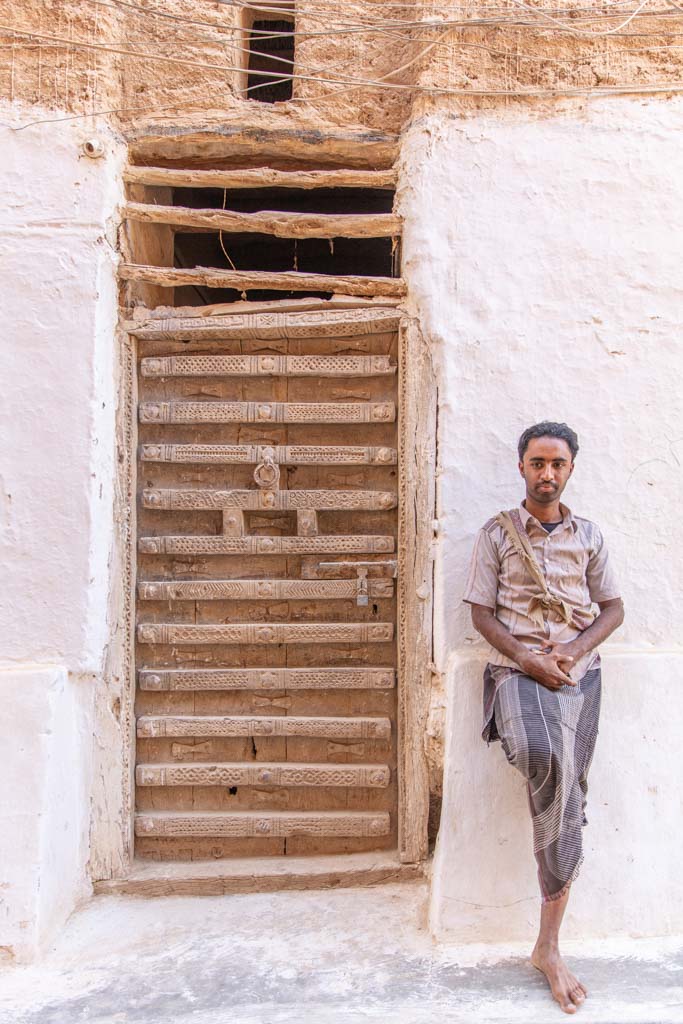

Shibam was devastated by a massive flood in 1532, as the city’s raised elevation didn’t protect it from the largest of torrents. The mudbrick foundations of many of the high-rise buildings were badly damaged when water surged through the Hahdraumant region.
There are still some original structures left standing in Shibam, including a 10th century mosque and a 12th century castle. Currently, Shibam’s fortified old city consists of over 500 dwellings.
Later in the 16th century, Shibam would be fortified by the addition of a wall built around the existing city to help prevent the same damages from another devastating flood.
Maintenance of the mudbrick skyscrapers is an evergoing process with mud being brought in from the surrounding harvested crops to repair eroded and broken bricks on the ancient structures.


Freya Stark would pass through Shibam in the 1930s and coin the nickname “the Manhattan of the Desert” to Shibam, owing to its unique mudbrick skyscrapers sat in the middle of Wadi Hadhramaut. In 1982 Shibam would go on to be listed as UNESCO World Heritage Site.
It hasn’t been smooth sailing for Shibam since its inscription as a UNESCO site, as several extremist attacks have been carried out in and around the city. In 2009 a suicide bombing was carried out at the famed viewpoint from which most onlookers would go to see the city at sunset, killing four South Korean tourists and their Yemeni guide.
In 2015 AQAP (Al Qaeda in the Arabian Peninsula) attempted to take over Shibam and detonated a car bomb at a nearby checkpoint leading into the city. Subsequently, Shibam was added to the list of World Heritage in Danger.
At present approximately 7,000 people live in Shibam.
Click here to read about Tarim, the Sufi center of the Hadhramaut

Viewing Shibam From Ground Level
We actually visited Shibam twice. The first time, as we came from the Yemeni Empty Quarter via the Sufi center of Tarim, passing Shibam on our way to explore the ethereal Wadi Daw’an.
Our second visit would be when we were able to fully explore the walled city and witness the Maghrib prayer during sunset from a viewpoint.

We first stopped just off the main Seiyun-Shihan Road, viewing the city from outside its south-facing walls. We viewed Shibam from a dusty field in front of an outcrop of buildings with a perfectly placed date palm and a puddle the reeked of sulfur but made for great photos giving us the opportunity to capture the city’s reflection.

Maruf al Habiti Mosque
As we continued on toward Wadi Daw’an, about half a kilometer from where we first broke for views of the city, we stopped again, walking across a dusty harvested crop to view the city from the west. From here we had views of the bright white Maruf al Habiti Mosque that lies just outside the fortified walls of Shibam.

Inside The Walled City
Upon our return to Shibam after exploring Wadi Daw’an, we entered the city through its main south gate. From here we continued on foot exploring every nook we possibly could.

Maruf Ba Jamal Mosque
We parked near the Shibam souq and started our stroll through the narrow alleys between the mudbrick giants. The first site was the Maruf Ba Jamal Mosque, named after 16th century scholar Jamal Maruf.
Check out this post to read what it was like to camp under the stars in the Yemeni Empty Quarter



Wandering The Narrow Alleys
We followed a narrow passage of cobblestone set between sky-high mudbrick buildings to a square, stopping to appreciate architecture, wave salaam back to children and parents who poked their heads out of highrise apartments at the sound of us walking along the narrow streets to where the Museum of Shibam and Handicraft Center For Society Development is located.

On the way as we whispered back and forth in English to each other a young woman in a billowing abaya and niqab grabbed my arm. She cheerfully introduced herself as Fatma and asked my name before welcoming me into her country and city. She told me that seeing us and meeting me made her very happy as she hadn’t seen hardly any tourists at all in the last 10 years in Shibam due to the ongoing war and the previous issues Shibam was having before the war officially commenced.
Fatma spoke English incredibly well. I asked her where she picked it up and it turns out she learned at her school here in Shibam but insisted that her language skills were not great. We finally parted ways as she was on her way to a class, just before reaching the square.

Check out this post to see the most beautiful village of Haid al Jazil

Shibam Museum & Handicraft Center For Society Development
We eventually arrived at a decently large square given Shibam’s compact nature, near the northern boundaries of the fortification. From here we entered the Shibam Museum and Handicraft Center. The museum caretaker, a young man donning a long-sleeve button-down shirt and traditional Yemeni fouta was patiently waiting for us at the front door.
The bottom floor had displays of photos of Shibam. We quickly headed up to the next level that housed a shop where you could purchase Yemeni jewelry, paintings, trinkets, postcards, and more. They even had a model of a Hadhrami Shibam home.
Down the hall were rooms serving as exhibits as to the layout of these traditional homes.



A wall displayed the traditional Yemeni wooden locks further down. At the end of the hall, we inspected the Hadhrami-style hand-carved wooden window frames. A room off to the right with a sky-blue ceiling displayed a hand-carved pillar as well as several Shibam artifacts.

After exploring the remainder of the rooms of the museum we continued onto the roof of the building for aerial views across Wadi Hadhramaut. Before departing the museum and handicraft center we all purchased various items to support the project.

Wanna go to Socotra? Check out my Socotra Travel Guide to start planning


Shibam Center Of Yemeni Dress Weaving
Shibam Museum caretaker, locked up the museum and handicraft center and toured us around Shibam with Kais. Just a short walk away from the square and museum he lead us to the Shibam Center of Yemeni Dress Weaving. He unlocked the over century-old wooden door to reveal a loom used for weaving the traditional fouta.
Fouta are the large woven cloth that men wear (we nicknamed them ‘man-skirts’) wrapped around their waist similar to the longyis worn by people across the country of Myanmar. Fouta characteristically have intricate designs and patterns woven into the lower edge of the fabric.
We were given a brief demonstration on the loom used to weave the fouta fabric.
Learn everything you need to know to cross the Yemen-Oman border in Surfeet

Batheeb Mosque
Just down the alley from the museum and the dress weaving center, we passed the Batheeb Mosque. Batheeb Mosque was founded by Abdulrahman Omar Batheeb and built in the 11th century.
Learn more about nearby Wadi Daw’an

Alibaba Treasure
As we continued weaving our way down narrow tan and white alleys we eventually passed the Alibaba Treasure shop. This shop was well known for selling Hadhrami silver and antiques. Several antique hand-carved Hadhrami doors were strewn along the front wall, next to two stacks of wooden chests adorned with silver handles and details, and several wooden stools.

Wanna visit Yemen? Learn what you need in order to get a Yemeni visa
An Impromptu Concert
As we meandered the maze of paths toward the southwestern edge of the walled city, passing goats and cats appearing to wander as aimlessly as we along the cobbled track. The faint chatter of children playing in the streets and passing smiling faces quietly whispering a warm marhaba as we move past each other.



There’s something unmistakably magical about the rambling pathways of Shibam in the late afternoon, a city akin to a living museum, peacefully quiet but very alive.
As we approached the walls of Shibam we heard music playing from an upstairs window of one of the mudbrick dwellings. We all paused for a minute listening, thinking it was a recording. Pretty soon two heads popped out of the window, hearing the sound of our voices in the silent alley.
We were wrong.
It wasn’t a recording of Yemeni music playing it was actually the sound of one of the men playing the oud. Before long they invited us into their home to listen to his music. He strummed away at his oud to our amazement.
An oud is a pear-shaped, guitar-like instrument of 11-13 strings that has been popular in Arabian, Persian, and other Middle Eastern music for centuries.
Next, he pulled out a violin and continued to play a couple more pieces for us. I would have never thought wandering into Shibam earlier in the afternoon, and given the silence of the city, that we’d be sat down in a home, likely hundreds of years old, in Shibam listening to the sound of the oud and violin being played.




The Shibam Promenade
Along the walls of Shibam, you can follow a cobblestone path along the western walls of the city that offer sweeping views across the wadi.



Jameh Mosque
After our unexpected concert, we bid our farewells to our new musician friend and continued past Jameh Mosque. Jameh Mosque (Great Mosque), is also known as Sheikh Ar Rashid Mosque. Jameh Mosque’s origins date back to 753 AD, but completion of the mosque didn’t occur until 10th century.
The mosque was built using red baked bricks, that were popularly used in the Abbasid era under the reign of Harun al-Rashid. This is the only structure in Shibam where these red baked bricks are found, though at first glance you wouldn’t notice the red bricks as the mosque is covered in a coat of blinding white paint. The Baroque-style minaret that currently stands at the corner of the mosque was actually rebuilt in the 1970s.
Jameh Mosque is quite large in comparison to many of these other dwellings in Shibam’s walled city. It sits on the main square near the entrance gates to the city and the souq.

Shibam Souq
The Shibam Souq is the most bustling part of the near-silent city. At the edge of the souq, men sat on a mauve cloth, drinking sweet shai and playing dominos, slapping down pieces between adding more qat leaf to their cheek, passing the afternoon away. A small ramshackle outdoor teahouse under an awning operated just a few meters from the man sat playing dominos.
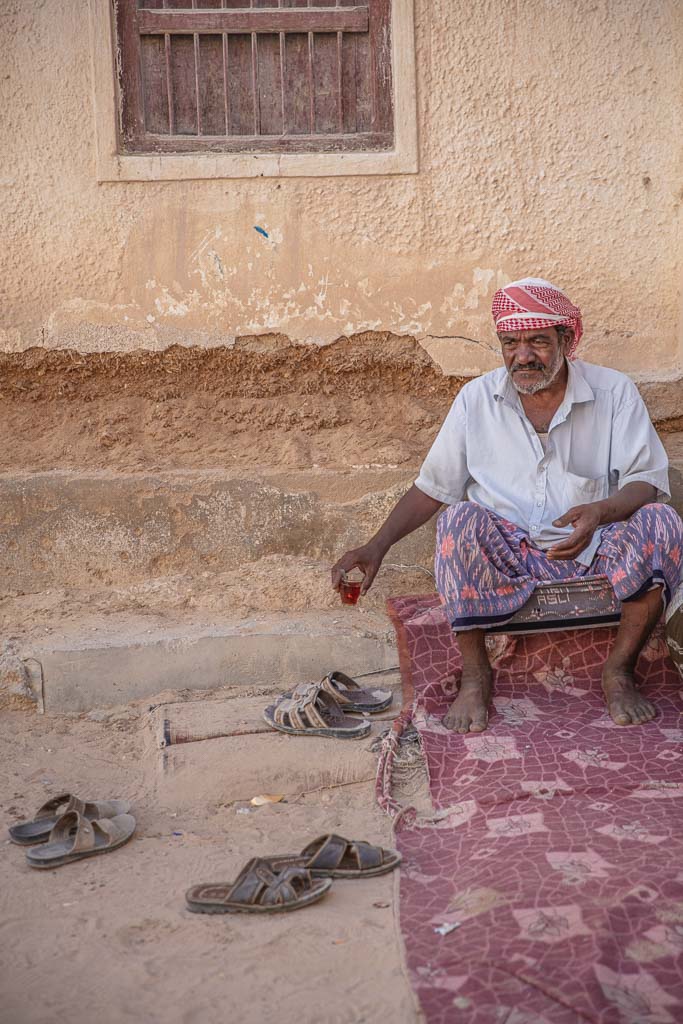
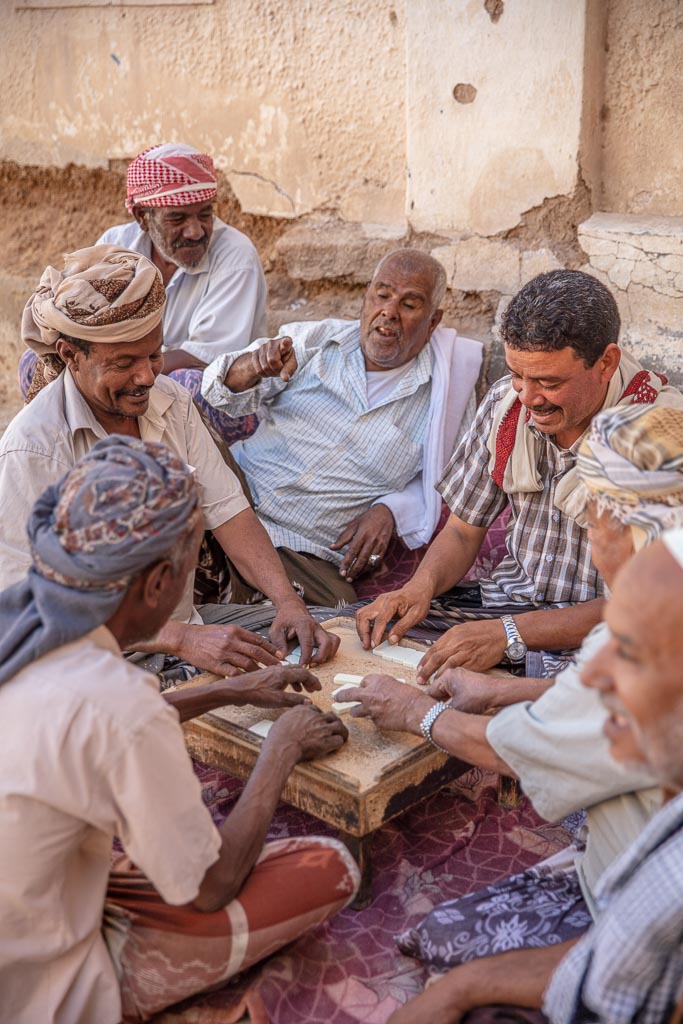

The souq was a great reminder that despite the turmoil much of the nation is in currently, life still goes on. It was something I had forgotten, but seeing this spurred my memories of sitting atop the Bab al Yemen in Sana’a in 2014, just before the official start of the civil war.
At that point in time, I’d never traveled to a country on quite the same level of chaos as Yemen was in (the downward spiral had begun long before my first visit).
I had no idea what awaited me when I stepped foot out of Sana’a Airport. I quickly realized that no matter the turmoil and chaos, terrorism and explosions aside, life still went on- which was evident from the ant-like frenzy of the people in Sana’a’s ancient souk on that early evening at the close of my first day in Yemen six years prior.

The sun was beginning to drop, so after an all-too-short visit to the Shibam Souq, we walked back to the square to hop in the car with Wagdi and head across the highway to pass through New Shibam on the way up Jabal Khidba.

Wanna read more about Sana’a & Dar al Hajar?

Climbing Jabal Khidba
Jabal Khidba is the craggy precipice that forms the southern boundary of New Shibam and the southern fringe of Wadi Hadraumaut’s broad valley. We drove up a narrow street the climbed a short way uphill before we parked. From here, it was a short walk to the best viewpoint of Shibam for sunset.
After about 10 minutes of walking, we reached a small salmon-colored fort from which most the odd tourist who visits Shibam these days go to catch the sunset. A bit higher up from the fort was a bench under an awning. We moved around from the lower to the upper area scoping out the best spots for sunset.
Before long, the two American tourists we had met previously in Wadi Daw’an showed up, along with three others on a shorter journey in mainland Yemen that would travel to Socotra with them afterward.
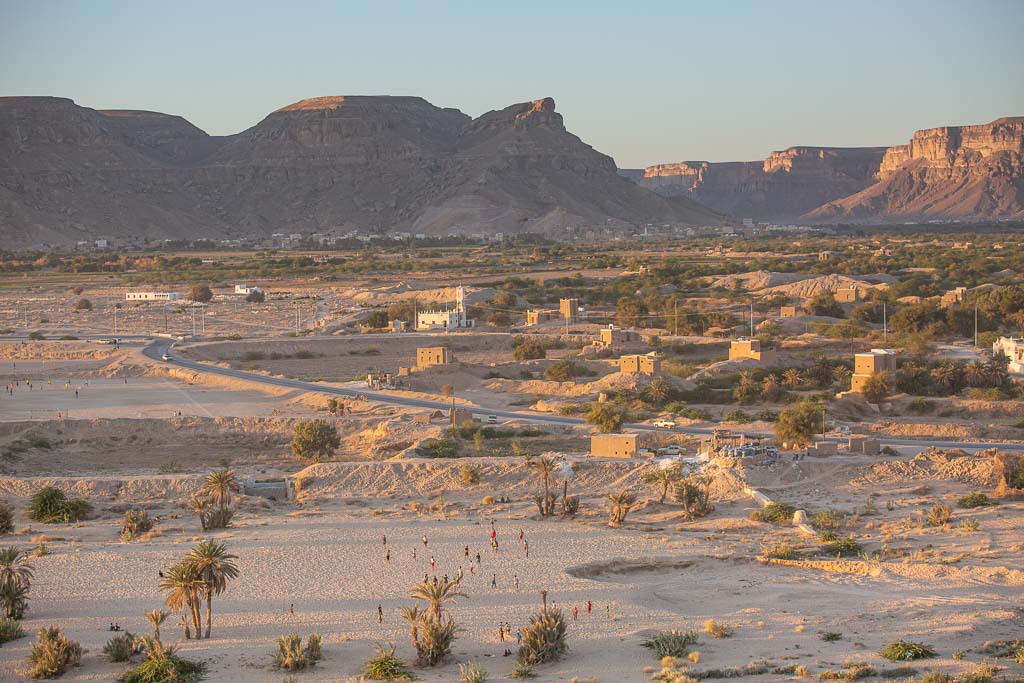
We all decided the best place to perch for the Maghrib call to prayer was a large boulder, big enough to fit six of us comfortably as we watched boys and young men play football in the empty fields between us and the walled city.

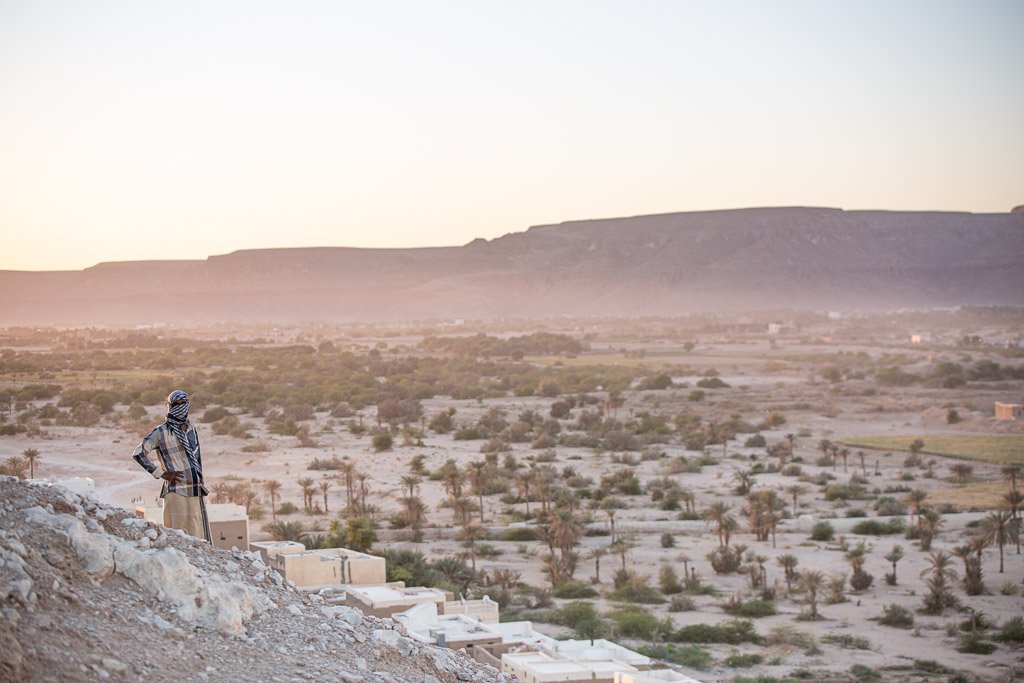
As the sky darkened from pink to purple, the sound of the Maghrib rang out, echoing across the walls of Wadi Hadhramaut.
Unfortunately, the recording I have of it is nowhere near as magical as the sound was in person (my phone mostly picked up the sound of the howling breeze billowing down the wadi, with the faint sound of the call in the background).


It seemed to last eons (looking down at my phone later it was only about four minutes in total). Once the call stopped, Kais was adamant about getting back down to the car as soon as possible.
After all, this is the exact location of where the 2009 attack happened. The few guides that operate in this area don’t take this lightly, they will be armed with a Kalashnikov.

As we began our race down the hill under the setting sun (which seemed a bit too low for our leader’s comfort), a second call to prayer rung out as thirst stars began to glimmer in the periwinkle hued sky. I’ll just say this- trying to run down a narrow path down a hill in the near-dark while wearing an abaya that limits your stride, and a niqab that keeps flapping up and obstructing your vision, and not falling over or tumbling down the hill, is not the easiest feat.


In less than half the time it took us to walk to the top we were at the bottom, Wagdi already waiting with all the car doors open ready for our quick escape from Shibam. It didn’t feel like the doors were even shut and we already barreling down the highway toward Seiyun where we’d be spending the night before our early morning departure to Socotra.
We spent the remainder of the evening in Seiyun at a restaurant, meeting for dinner with a young and sassy teacher from Northern Yemen, who had moved with her family to the Hadhramaut to escape the way. She was a real treat to spend the evening laughing with, sharing her aspirations for the future, and her hopes for Yemen moving forward, we now talk almost every day on What’sApp.


Have Questions About Visiting Yemen’s Walled City Of Shibam
I arranged this unique addition to a trip into Mainland Yemen and on to Socotra with a local contact. If you want to set up your own, contact me at adventuresoflilnicki @ gmail.com.
Need Travel Insurance for Yemen?
Start shopping plans over at battleface.




